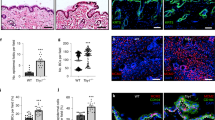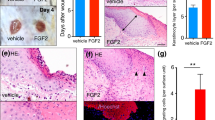Abstract
IN the epidermis proliferation of keratinocytes is restricted to the basal layer, which is in contact with the basement membrane, and cells undergo terminal differentiation as they move upwards through the suprabasal layers. In stratified cultures of human keratinocytes, upward migration is a consequence, not a cause, of terminal differentiation1 and occurs because keratinocytes become less adhesive to their substratum and to one another2. Most keratinocytes can be induced to differentiate to completion by placing them in suspension in methylcellulose3: within 12 h DNA synthesis is irreversibly inhibited and by 24 h most cells express involucrin (ref 4; P. A. Hall, J.C.A. and F.M.W., unpublished observations). Here we report that when fibronectin is added to the methylcellulose, keratinocytes still withdraw from the cell cycle, but induction of involucrin expression is largely inhibited. The effect of fibronectin is concentration- and time-dependent and is mediated by a receptor of the integrin family5. These results provide an explanation for why overt terminal differentiation is normally restricted to suprabasal cells, whereas cell-cycle withdrawal occurs within the basal layer; they also have important implications for the mechanism of epidermal wound healing. Furthermore, our data show that the binding of an extracellular matrix protein to its receptor can regulate differentiated gene expression in the absence of changes in cell shape.
This is a preview of subscription content, access via your institution
Access options
Subscribe to this journal
Receive 51 print issues and online access
$199.00 per year
only $3.90 per issue
Buy this article
- Purchase on Springer Link
- Instant access to full article PDF
Prices may be subject to local taxes which are calculated during checkout
Similar content being viewed by others
References
Watt, F. M. & Green, H. Nature 295, 434–436 (1982).
Watt, F. M. J. Cell Biol. 98, 16–21 (1984).
Green, H. Cell 11, 405–416 (1977).
Watt, F. M., Jordan, P. W. & O'Neill, C. H. Proc. natn. Acad. Sci. U.S.A. 85, 5576–5580 (1988).
Ruoslahti, E. A. Rev. Biochem. 57, 375–413 (1988).
Watt, F. M. J. Cell Sci. Suppl. 8, 313–326 (1987).
Fava, R. A. & McClure, O. B. J. cell Physiol. 131, 184–189 (1983).
Anzano, M. A., Roberts, A. B. Smith, J. M., Sporn, M. B. & De Larco, J. E. Proc. natn. Acad. Sci. U.S.A. 80, 6264–6268 (1983).
Potten, C. S. & Morris, R. J. J. Cell Sci. Suppl. 10, 45–62 (1988).
Pierschbacher, M. D. & Ruoslahti, E. Nature 309, 30–33 (1984).
Hynes, R. O. Cell 48, 549–554 (1987).
Akiyama, S. K. & Yamada, K. M. J. biol. Chem. 260, 10402–10405 (1985).
Stenman, S. & Vaheri, A. J. exp. Med. 147, 1054–1064 (1978).
Grinnell, F., Toda, K-I. & Takashima, A. J. Cell Sci. Suppl. 8, 199–209 (1987).
Colvin, R. B. in Fibronectin (ed. Mosher, D. F.) 213–252 (Academic, New York, 1989).
Pennypacker, J. P., Hassell, J. R., Yamada, K. M. & Pratt, R. M. Expl Cell Res. 121, 411–415 (1979).
Podleski, T. R., Greenberg, I., Schlessinger, J. & Yamada, K. M. Expl Cell Res. 122, 317–326 (1979).
West, C. M. et al. Cell 17, 491–501 (1979).
Spiegelman, B. M. & Ginty, C. A. Cell 35, 657–666 (1983).
Patel, V. P. & Lodlsh, H. F. J. Cell Biol. 105, 3105–3118 (1987).
Adams, J. C. & Watt, F. M. J. Cell Biol. 107, 1927–1938 (1988).
Read, J. & Watt, F. M. J. invest. Dermat. 90, 739–743 (1988).
Rupniak, H. T., Turner, D. M., Wood, E. J. & Cunliffe, W. J. J. invest. Dermat. 87, 164 (1986).
Zardi, L. et al. Eur. J. Biochem. 146, 571–579 (1985).
Yamada, K. M. In Fibronectin (ed. Mosher, D. F.) 47–121 (Academic, New York, 1989).
Dedhar, S., Argaves, W. R., Suzuki, S., Ruoslahti, E. & Pierschbacher, M. D. J. Cell Biol. 105, 1175–1182 (1987).
Author information
Authors and Affiliations
Rights and permissions
About this article
Cite this article
Adams, J., Watt, F. Fibronectin inhibits the terminal differentiation of human keratinocytes. Nature 340, 307–309 (1989). https://doi.org/10.1038/340307a0
Received:
Accepted:
Issue Date:
DOI: https://doi.org/10.1038/340307a0
This article is cited by
-
Neuronal contact guidance and YAP signaling on ultra-small nanogratings
Scientific Reports (2020)
-
Squamous differentiation requires G2/mitosis slippage to avoid apoptosis
Cell Death & Differentiation (2020)
-
In Vitro Expansion of Keratinocytes on Human Dermal Fibroblast-Derived Matrix Retains Their Stem-Like Characteristics
Scientific Reports (2019)
-
Substrate softness promotes terminal differentiation of human keratinocytes without altering their ability to proliferate back into a rigid environment
Archives of Dermatological Research (2019)
-
Regulation of ERK-MAPK signaling in human epidermis
BMC Systems Biology (2015)
Comments
By submitting a comment you agree to abide by our Terms and Community Guidelines. If you find something abusive or that does not comply with our terms or guidelines please flag it as inappropriate.



